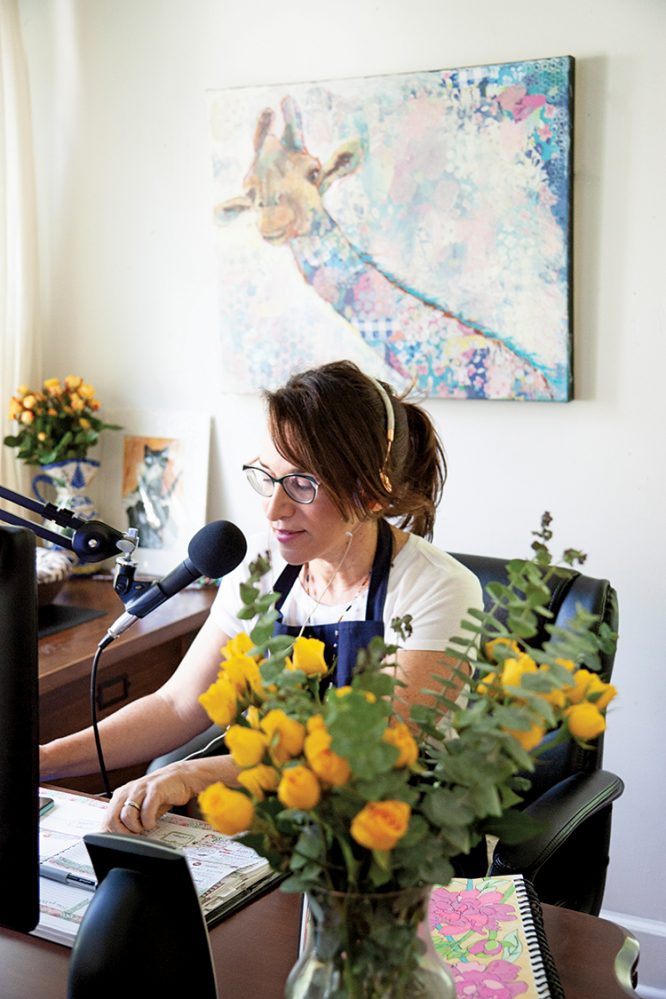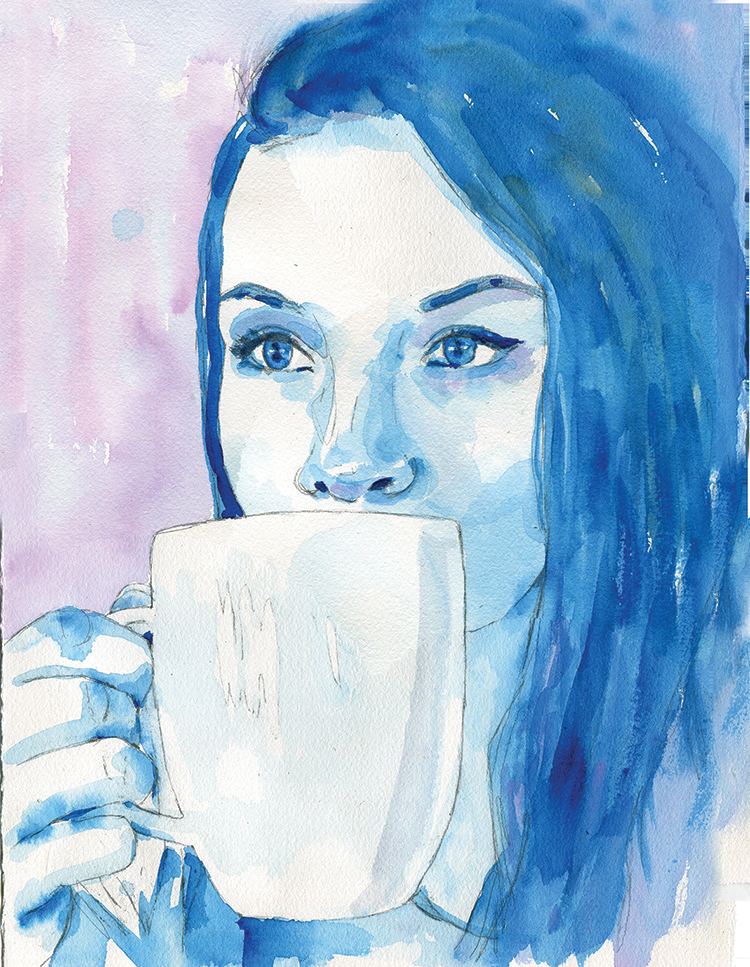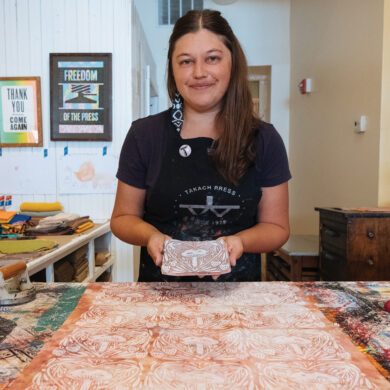This is the 1st of your 3 free articles
Become a member for unlimited website access and more.
FREE TRIAL Available!
Already a member? Sign in to continue reading

When I was in the fourth grade, my teacher asked me to design our class Halloween pumpkin and crowned me “the class artist.” This marked the first time in my life that I had been called an “artist,” or even thought of myself in that way. You could say my teacher discovered unrecognized, artistic talent. However, another version of this story, the one that feels “true”, is that my teacher declared I was an artist, and I chose to believe her. This belief ultimately drove me to answer the call.
Nevertheless, back then I didn’t believe I could make a living as an artist (which is why I never went to art school.) Straddled with student loans, I took the practical route and headed for Wall Street. Although I loved the income of a financial analyst, I felt disconnected from my life’s purpose. After witnessing the devastation of 9/11, I abandoned my lucrative hedge fund job and set off to find my path.
After I quit my job, I started painting on the side and taught Pilates at New York Sports Club. While working for the gym, I was introduced to strategies used to sell personal training packages. It was then that I had my “aha” moment and realized that these time-tested methods could be used to sell anything, including art. If I was going to turn my energy towards marketing, I wanted to sell something I was truly passionate about.
The Bat Signal That Changed My Life
If I had any lingering doubts that I would dedicate myself to selling my art, the universe conspired to keep me out of the Pilates studio with an emergency appendectomy, followed by a broken toe. My love affair with portraits really kicked off during this time. I painted my then-four-year-old son in his Batman costume.
He loved the painting so much that he proudly showed it off to his friends when they came over for playdates. Those kids showed their parents when they came to pick up their children, and pretty soon I was painting my son’s friends…and then more people saw those portraits and asked me for commissions. All along the way, I incorporated the marketing strategies I had learned while working at the gym and integrated new ones I was learning. Pretty soon I had a thriving business painting portraits! I started selling my art online and eventually expanded my repertoire, adding different mediums and techniques.
Most of my commissions come from getting local press and proactive word-of-mouth marketing. My website acts as a portfolio and credibility tool to close high-end commissions. When I first started my art business, we didn’t have social media, but many artists were selling art on eBay and Etsy.
At the time, I had piles of life drawing sketches that I auctioned off on eBay and I also listed my watercolor and mixed media paintings on Etsy. Although I could’ve relied on my in-person efforts alone to sell artwork, putting my art on alternative online venues introduced my art to a wider audience. Through Etsy, I received opportunities that led to getting my art featured on television shows such as NBC’s “Parenthood” and the Amazon series “Hunters” with Al Pacino.
The Inspiration Place
Other Etsy artists started reaching out to me to ask if I could teach my painting techniques to them….online. Back in 2012, I had never heard of online learning, but I was intrigued and wanted to figure out how to do it. That’s when I created The Inspiration Place, which is my platform for teaching online art classes such as Watercolor Portrait Academy and Watercolor Secrets. My classes teach techniques but also help beginner artists get past the fear and doubt to truly enjoy painting their passion. Some of my students haven’t picked up a paintbrush since college; others have always wanted to and they’re doing it for the first time, and there are also those artists who are old pros looking for new tricks.
Online Marketing
In the beginning, I struggled to understand how to market online art classes but was determined to make it happen. I saw other artists offering online classes, and they made it look so easy. I naively thought all I had to do was make a few posts on social media; however, all I got from those first attempts were crickets. After investing in online courses that taught me how to market and build an email list, I finally figured out how to connect with students. Armed with these additional marketing techniques, I implemented better strategies, and popularity in my online classes took off. Moreover, using email marketing also helped me sell more art.
“Well-behaved women seldom make history.” —Laurel Thatcher Ulrich

Voice to My Story
I felt like I had so much to share about how I built my art business that I created the Inspiration Place Podcast to give a voice to my story. The podcast now reaches thousands of artists in over 50 countries. After dozens of episodes on mindset, marketing, building your email list, attracting high-end commissions, and more, people begged me for a way to get even more personalized help. As a result, I developed the Artist Incubator Coaching Program as a way to help artists to master the art of sales and marketing so that they could also grow thriving art businesses. The artists who join the program learn the principles of closing high-end sales and master email marketing. All the marketing I use relies on time-tested principles rather than social media fads. Artists spend enough time on their phones, and their creativity should be saved for creating beautiful art rather than content for the Zuckerverse.
Should You Podcast?
You can reach a larger audience by podcasting, but it’s not for everyone. Many of my listeners think that I make money from the podcast, and that isn’t true. Unless you have sponsors paying you to post their content or advertisements on your show, creating a podcast is an expense, not an income generator. I use the podcast to inspire artists to create an abundant mindset. Consequently, sharing free content has attracted new art students and clients to my programs. This has helped me nurture relationships with other artists, authors, and marketing experts. If you’re a teacher or want to be seen as a leading expert, podcasting is an excellent way to build your network and your audience. Alternatively, you can also create free content through a weekly blog or a YouTube channel.
Be a Guest
You can tap into the power of podcasting by being a guest on other people’s podcasts. Artists who have been on my podcast see an immediate bump in their Instagram follower count. There are literally millions of podcasts to choose from and depending on the kind of art you create, you may want to consider approaching a podcast that isn’t about art! For example, if you’re a wildlife artist, you may want to consider pitching a story to a podcast that talks about animals.
In this handy guide, I’ve shared some of my best tips for getting featured as a guest on a podcast. If it sounds like a lot of work, just know that the host will be doing a lot of work to promote the show, and this is a great way to show them that you’re a willing partner in that promotion.
Tech Tips
Whether you choose to start your own podcast, get interviewed on other people’s shows, create online art classes, or start a YouTube channel, you’ll need to invest in quality equipment. To help you get started, I’ve got another free resource for you! This is a complete shopping list of all the equipment I use on a regular basis to record podcasts and create art videos. To grab that equipment guide, go to schulmanart.com/

How to Be an A+ Podcast Guest
Before you pitch:
- Listen to at least one of the podcast’s recent episodes
- Leave a sincere 5-star review on Apple podcasts
- Follow the host on social media and comment on their posts
- Share a podcast episode on social media
Tech set-up:
- Invest in a quality external microphone such as a Yeti
- Test your equipment with a friend
- Make sure you have an ethernet to plug into! Unfortunately, I’ve had to cut large portions of interviews when a guest had a shaky wifi connection and sometimes have canceled episodes completely!
- Be sure you have headphones so there’s no dreaded echo
- Skip earrings! Metal earrings will also interfere with the connection and may rub against your headphones.
Create a prep sheet to share with your host that includes:
- Your contact information and all social media handles
- A brief bio for the host to use to introduce you
- A longer bio that the host may place on their website for the show notes
- Some amazing high-res images of yourself (no selfies please!) that the host can use on their website and while promoting the interview
- A list of talking points for your host
Day of the show:
- Show up on time with your phone turned off
- Give your lips a swipe of lip balm to eliminate lip smacks
- Have water (with a lid) and no ice (you’ll hear the ice cubes)
- Share any posts the host made with your followers
- Comment underneath the posts
- Send a link to the podcast interview to your email list
Answer the Call and Commit to Your Art:
DO YOU BELIEVE IN MAGIC? As creatives, we hear those whispers from the universe asking us to answer that call, and our resistance to take that leap of faith is a refusal to answer that call. For us creatives, the call is to dedicate your life purpose to your art. Art is a calling. Becoming an artist is not much different than becoming a wizard. Your wand is your paintbrush, your pen, your camera, your computer, your instrument, or whatever tool you wield in your craft. Creating something with the power of your imagination is incredible magic. In episode #48 of The Inspiration Place podcast [schulmanart.com/148], you’ll discover the motivational push to answer the call.
The Art of Guest Podcasting: If you want to learn more about guest podcasting, this episode is for you. We unpack the steps to research and approach hosts, what marketing materials you need in place and provide you with a free podcast guest checklist. [schulmanart.com/21]
Where Women Create: Go behind the scenes and meet WHERE & WHAT Women Create’s Editor in Chief, Jo Packham. You’ll learn what she looks for when choosing artists for this magazine! [schulmanart.com/154]

When I was in the fourth grade, my teacher asked me to design our class Halloween pumpkin and crowned me “the class artist.” This marked the first time in my life that I had been called an “artist,” or even thought of myself in that way. You could say my teacher discovered unrecognized, artistic talent. However, another version of this story, the one that feels “true”, is that my teacher declared I was an artist, and I chose to believe her. This belief ultimately drove me to answer the call.
Nevertheless, back then I didn’t believe I could make a living as an artist (which is why I never went to art school.) Straddled with student loans, I took the practical route and headed for Wall Street. Although I loved the income of a financial analyst, I felt disconnected from my life’s purpose. After witnessing the devastation of 9/11, I abandoned my lucrative hedge fund job and set off to find my path.
After I quit my job, I started painting on the side and taught Pilates at New York Sports Club. While working for the gym, I was introduced to strategies used to sell personal training packages. It was then that I had my “aha” moment and realized that these time-tested methods could be used to sell anything, including art. If I was going to turn my energy towards marketing, I wanted to sell something I was truly passionate about.
The Bat Signal That Changed My Life
If I had any lingering doubts that I would dedicate myself to selling my art, the universe conspired to keep me out of the Pilates studio with an emergency appendectomy, followed by a broken toe. My love affair with portraits really kicked off during this time. I painted my then-four-year-old son in his Batman costume.
He loved the painting so much that he proudly showed it off to his friends when they came over for playdates. Those kids showed their parents when they came to pick up their children, and pretty soon I was painting my son’s friends…and then more people saw those portraits and asked me for commissions. All along the way, I incorporated the marketing strategies I had learned while working at the gym and integrated new ones I was learning. Pretty soon I had a thriving business painting portraits! I started selling my art online and eventually expanded my repertoire, adding different mediums and techniques.
Most of my commissions come from getting local press and proactive word-of-mouth marketing. My website acts as a portfolio and credibility tool to close high-end commissions. When I first started my art business, we didn’t have social media, but many artists were selling art on eBay and Etsy.
At the time, I had piles of life drawing sketches that I auctioned off on eBay and I also listed my watercolor and mixed media paintings on Etsy. Although I could’ve relied on my in-person efforts alone to sell artwork, putting my art on alternative online venues introduced my art to a wider audience. Through Etsy, I received opportunities that led to getting my art featured on television shows such as NBC’s “Parenthood” and the Amazon series “Hunters” with Al Pacino.
The Inspiration Place
Other Etsy artists started reaching out to me to ask if I could teach my painting techniques to them….online. Back in 2012, I had never heard of online learning, but I was intrigued and wanted to figure out how to do it. That’s when I created The Inspiration Place, which is my platform for teaching online art classes such as Watercolor Portrait Academy and Watercolor Secrets. My classes teach techniques but also help beginner artists get past the fear and doubt to truly enjoy painting their passion. Some of my students haven’t picked up a paintbrush since college; others have always wanted to and they’re doing it for the first time, and there are also those artists who are old pros looking for new tricks.
Online Marketing
In the beginning, I struggled to understand how to market online art classes but was determined to make it happen. I saw other artists offering online classes, and they made it look so easy. I naively thought all I had to do was make a few posts on social media; however, all I got from those first attempts were crickets. After investing in online courses that taught me how to market and build an email list, I finally figured out how to connect with students. Armed with these additional marketing techniques, I implemented better strategies, and popularity in my online classes took off. Moreover, using email marketing also helped me sell more art.
“Well-behaved women seldom make history.” —Laurel Thatcher Ulrich

Voice to My Story
I felt like I had so much to share about how I built my art business that I created the Inspiration Place Podcast to give a voice to my story. The podcast now reaches thousands of artists in over 50 countries. After dozens of episodes on mindset, marketing, building your email list, attracting high-end commissions, and more, people begged me for a way to get even more personalized help. As a result, I developed the Artist Incubator Coaching Program as a way to help artists to master the art of sales and marketing so that they could also grow thriving art businesses. The artists who join the program learn the principles of closing high-end sales and master email marketing. All the marketing I use relies on time-tested principles rather than social media fads. Artists spend enough time on their phones, and their creativity should be saved for creating beautiful art rather than content for the Zuckerverse.
Should You Podcast?
You can reach a larger audience by podcasting, but it’s not for everyone. Many of my listeners think that I make money from the podcast, and that isn’t true. Unless you have sponsors paying you to post their content or advertisements on your show, creating a podcast is an expense, not an income generator. I use the podcast to inspire artists to create an abundant mindset. Consequently, sharing free content has attracted new art students and clients to my programs. This has helped me nurture relationships with other artists, authors, and marketing experts. If you’re a teacher or want to be seen as a leading expert, podcasting is an excellent way to build your network and your audience. Alternatively, you can also create free content through a weekly blog or a YouTube channel.
Be a Guest
You can tap into the power of podcasting by being a guest on other people’s podcasts. Artists who have been on my podcast see an immediate bump in their Instagram follower count. There are literally millions of podcasts to choose from and depending on the kind of art you create, you may want to consider approaching a podcast that isn’t about art! For example, if you’re a wildlife artist, you may want to consider pitching a story to a podcast that talks about animals.
In this handy guide, I’ve shared some of my best tips for getting featured as a guest on a podcast. If it sounds like a lot of work, just know that the host will be doing a lot of work to promote the show, and this is a great way to show them that you’re a willing partner in that promotion.
Tech Tips
Whether you choose to start your own podcast, get interviewed on other people’s shows, create online art classes, or start a YouTube channel, you’ll need to invest in quality equipment. To help you get started, I’ve got another free resource for you! This is a complete shopping list of all the equipment I use on a regular basis to record podcasts and create art videos. To grab that equipment guide, go to schulmanart.com/

How to Be an A+ Podcast Guest
Before you pitch:
- Listen to at least one of the podcast’s recent episodes
- Leave a sincere 5-star review on Apple podcasts
- Follow the host on social media and comment on their posts
- Share a podcast episode on social media
Tech set-up:
- Invest in a quality external microphone such as a Yeti
- Test your equipment with a friend
- Make sure you have an ethernet to plug into! Unfortunately, I’ve had to cut large portions of interviews when a guest had a shaky wifi connection and sometimes have canceled episodes completely!
- Be sure you have headphones so there’s no dreaded echo
- Skip earrings! Metal earrings will also interfere with the connection and may rub against your headphones.
Create a prep sheet to share with your host that includes:
- Your contact information and all social media handles
- A brief bio for the host to use to introduce you
- A longer bio that the host may place on their website for the show notes
- Some amazing high-res images of yourself (no selfies please!) that the host can use on their website and while promoting the interview
- A list of talking points for your host
Day of the show:
- Show up on time with your phone turned off
- Give your lips a swipe of lip balm to eliminate lip smacks
- Have water (with a lid) and no ice (you’ll hear the ice cubes)
- Share any posts the host made with your followers
- Comment underneath the posts
- Send a link to the podcast interview to your email list
Answer the Call and Commit to Your Art:
DO YOU BELIEVE IN MAGIC? As creatives, we hear those whispers from the universe asking us to answer that call, and our resistance to take that leap of faith is a refusal to answer that call. For us creatives, the call is to dedicate your life purpose to your art. Art is a calling. Becoming an artist is not much different than becoming a wizard. Your wand is your paintbrush, your pen, your camera, your computer, your instrument, or whatever tool you wield in your craft. Creating something with the power of your imagination is incredible magic. In episode #48 of The Inspiration Place podcast [schulmanart.com/148], you’ll discover the motivational push to answer the call.
The Art of Guest Podcasting: If you want to learn more about guest podcasting, this episode is for you. We unpack the steps to research and approach hosts, what marketing materials you need in place and provide you with a free podcast guest checklist. [schulmanart.com/21]
Where Women Create: Go behind the scenes and meet WHERE & WHAT Women Create’s Editor in Chief, Jo Packham. You’ll learn what she looks for when choosing artists for this magazine! [schulmanart.com/154]
The Women Create Foundation is a catalyst for small but significant strides to empower women creators through grants that help bring projects to life and foster innovation.
Learn More










